| January
29, 2007
Presenting: Fire Station 227 – History,
Heroism and Community Connections in the Beach
Having just completed my interview with Lido
Chilelli, the creator of the Toronto International Beaches Jazz
Festival, I was planning to head east on Queen Street to find a
nice place for lunch. As I was walking eastwards, taking in the
streetscape, I realized that one place is and continues to be a
definite fixture in the Beach: just a few steps from the intersection
of Woodbine and Queen is Toronto Fire Station 227, housed in an
elegant historic building that is now more than 100 years old. I
thought there was a story in there somewhere and made up my mind
to pop in.
I decided to try my luck and drop in unannounced on the firefighters
for an impromptu interview. I opened the back door and saw a bunch
of firefighters’ uniforms hung up on hooks and thought I had
reached their change room. I concluded it was not a good idea to
barge in there. So I tried the side door and sure enough, after
a couple of knocks the door opened and one of the firefighters on
duty let me in.
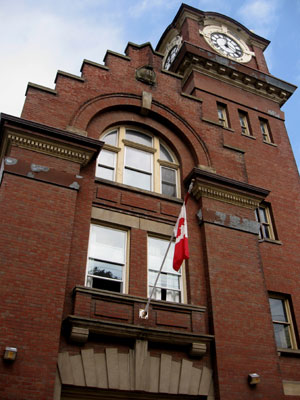
Fire Station 227, a historic landmark in the Beach
After I introduced myself and the “Celebrate
Toronto” project, Bill Libbus, a First Class Firefighter,
checked with his captain to see if it was okay for me to interview
him, and after he got the green light he started to show me around.
He first showed me the fire truck which was parked on the main floor
inside the fire station. A pair of firefighter’s boots and
a uniform were standing on the ground as if someone had flown right
out of them, and I thought that made a perfect humorous still life.
Then Bill showed me the fire tower, a 80 foot high tower that actually
has a purpose other than to just house the famous clock. The fire
tower is indeed used to hang up wet fire hoses that need to dry.
Bill added that most people don’t realize that the fire towers
on the old fire stations have a practical purpose; people often
think they are only there for decorative purposes or to house the
clock.
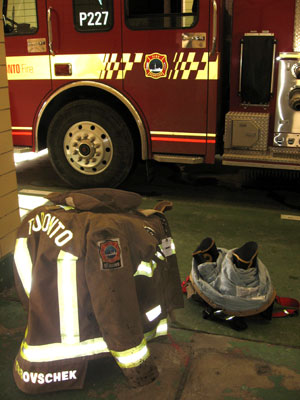
Humorous still life
Of course he also showed me the slide (actually two slides) that
firefighters would use to slide down from the second floor. And
he showed me an old gong used to rattle up the firefighters for
an emergency response, which actually is no longer in use today.
With most of the main sights covered, we sat down in the kitchen
and Bill started to educate me about the duties and the life of
Toronto firefighters. He himself has been here at this station for
17 years. The building is truly historic, it was built in 1905,
and more than 100 years ago firefighters would use horses to pull
their equipment. It was originally called Fire Station #17, but
since Toronto’s 1999 amalgamation with the former municipalities
of North York, East York, York, Etobicoke and Scarborough, the fire
station was renamed. Today, Fire Hall 227 has one pumper truck which
requires a crew of four firefighters: a captain who is in charge
and responsible for the safety of the three firefighters on his
crew.
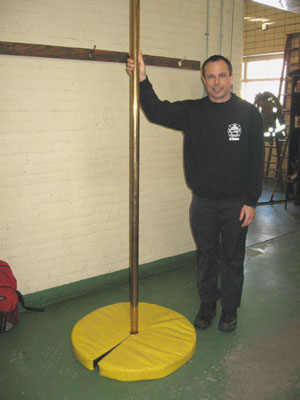
Bill Libbus with the metal pole
Bill explained that other fire stations might have more trucks,
or they might have different equipment, for example aerial trucks
which are equipped with ladders for emergency calls to high rise
buildings. I inquired into the routine of the firefighters, and
Bill explained that during the day they have regular training sessions
in order to re-familiarize themselves with safety, first aid, CPR,
fire and truck procedures as well as firefighter policies.
Fire fighters are first responders, which means that if someone
calls 911 because of a heart attack, often a fire truck will get
there first and provide CPR, oxygen or defibrillation equipment.
Toronto has more fire stations than ambulance stations which explains
why a fire truck might often be the first emergency vehicle to arrive
on the scene. Toronto firefighters often handle patient transport
to the hospitals and about 50% of their emergency calls are of a
purely medical nature.
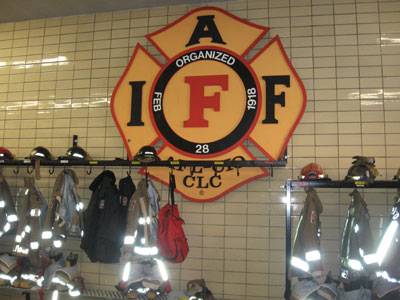
Logo in the fire fighters' change room
I learned that the area that Fire Station 227 is responsible for
stretches from Coxwell in the west to Victoria Park in the east,
and from the lakeshore in the south to Danforth Avenue in the north.
Bill explained that all fire calls require two pumper trucks, one
aerial truck and a fire chief. Each of Toronto’s 21 fire districts
has its own district chief who usually races to a fire in a red
van. When Station 227 responds to a fire, the aerial truck comes
from the fire station on Main Street. As an example, Bill mentioned
that today there was a fire in the Main and Danforth area in a private
house, and it took the crew four hours to extinguish the fire. The
fire chief was still scheduled to go back to the location later
today for further investigations.
As far as the Beach is concerned, Bill Libbus explained that almost
all the fires are residential in nature. There are very few high
rise buildings and no industrial locations in the area. About five
years ago there was a major fire at the eastern end of Queen Street
where two people died and about 20 fire trucks were called out.
When two pumper trucks and the aerial truck are not enough, additional
fire crews are called out with four vehicles each, and the response
to the emergency gets escalated into two, three, four or more alarm
fires, meaning that additional teams of four vehicles are pulled
in. Bill also referred to Toronto’s Great Fire of 1907 where
the whole city was burning. He could not even speculate how many
alarms this type of fire would have triggered. Literally every fire
fighter would have been called in to extinguish this historic inferno.
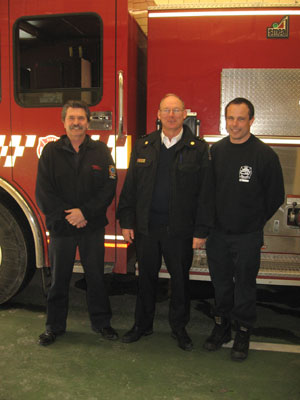
Captain Bill Elliot, District Chief Bob Buchan, Bill Libbus
I asked Bill how the perception of firefighters might have changed
since 911. He responded that firefighting is certainly a very highly
regarded profession, and that today there is a greater understanding
of his occupation. People now understand that firefighters go into
burning buildings and put their lives on the line to save others.
Bill quoted statistics that even today the average life span of
a fire fighter is ten years less than the average Canadian. These
statistics hold true despite better protective equipment. He added
that the constant exposure to stress and the resulting fluctuation
in adrenaline levels takes a toll on the body.
The role of the captain is to supervise the crew, but it is hard
to tell an active firefighter not to do any work and to refrain
from getting involved hands-on in a real fire. Bill said that it
is a very rewarding profession that enjoys the respect of the community.
Fire Station 227 experiences about five to eight runs a day, or
about 1500 runs a year. About 50% of the runs are fire-related,
i.e. when someone smells smoke, or a smoke detector goes off, the
fire department has to come out to investigate.
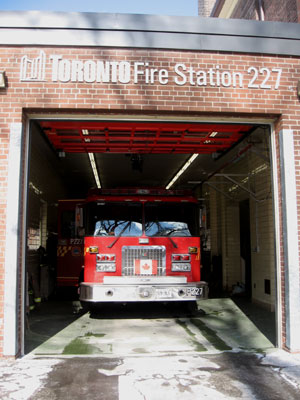
Fire Station 227's fire truck
The lifestyle of a firefighter is also highly unique: at present
his station is trying out a 24-hour shift system for a year. This
means for example that a firefighter would work for 24 hours from
Monday 7 am to Tuesday 7 am. Then they would come in again on Thursday
at 7 am and work 24 hours until Friday morning. After this they
would have six days off. In the second week their two 24 hours shifts
would go from Friday to Saturday morning and from Sunday to Monday
morning. Then the cycle for the first week would start again.
Being on a 24-hour shift means that the firefighters have to actually
live in the fire hall and cannot leave the premises. As a result
they actually go grocery shopping in full uniform in their truck,
just to be ready to respond in case they get an emergency call.
Fire Station 227 has 4 shifts with 20 people working here and each
truck has five firefighters working on it. Bill has worked with
his colleagues for a long time, and it certainly takes mutual consideration
to be living with a group of colleagues in such close quarters.
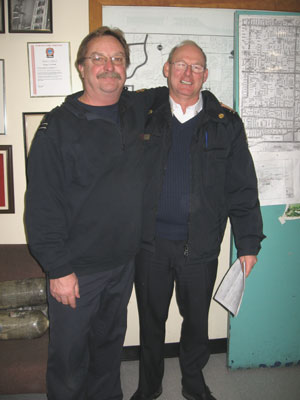
Chief's Aide Pat McFarlane and District Chief Bob Buchan
Another unique responsibility of fire fighters in the Beach is
water rescue. Bill clarifies that they are responsible for shore
water rescue, while rescues in the lake are to be handled by fire
boats, police and EMS boats. Every year there are several drownings
or near-drownings in the Beach, so the water rescue skills of these
firefighters are called on frequently.
Bill also explained that all fire trucks are equipped with a GPS
system so they can always be traced by the dispatch office and pulled
in on a local emergency. A tiered response system directs fire trucks
from different areas to where they are needed, with the closest
trucks responding first. The truck from the fire station in the
Beach routinely goes as far north as North York to help out with
emergency calls there.
Bill Libbus had given me an extremely informative introduction
to firefighting in Toronto, and just before I left I had a chance
to take some pictures of three of his colleagues. He also said I
just missed one of his co-workers, Doug Browne, who is a real character
and would have been a great interview candidate. I thought I might
just try to come back in the next few days and have a chat with
Doug as well. This brief visit had definitely been very enlightening,
and I was glad I made this impromptu visit to Fire Station 227.
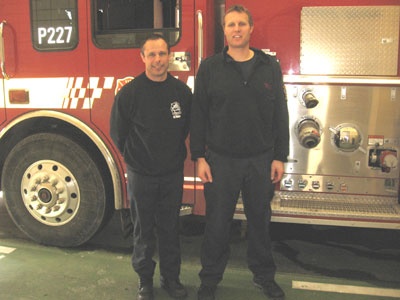
Bill Libbus and Derek Clausen from the Main Street Fire Station
February 1, 2007: A Conversation with Doug
Browne – A Local Boy Working at the Local Fire Hall
The theme of the day was firefighting. After my interview with
Ralph Noble, also a firefighter and
the creator of the famous Balmy Beach
Mural, I decided to pay another visit to Fire Station 227 where
I thought I would try to see if I could connect with Doug Browne,
the firefighter that Bill Libbus had mentioned a few days ago. Chances
were far from certain, considering the firefighters’ complex
schedule which involves numerous days off in between shifts.
I knocked on the side door again, and one of the firefighters opened
the door. I was in luck: Acting Captain Doug Browne was at work
today, and I would have a chance to meet this outgoing gregarious
guy. Doug came downstairs and it was immediately obvious that he
enjoys dealing with people. We went upstairs to sit down in a quiet
room so Doug would be able to tell me more about himself.
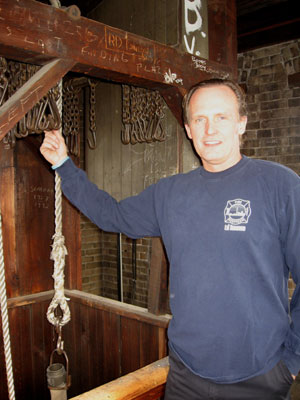
Doug Browne, up in the fire tower, showing the hooks for hanging
the hoses
Doug Browne is a Beacher through and through. His dad, Chief Bill
Browne, also a firefighter, and his mom Rodene Browne, raised him
on Hambly Avenue. Doug affectionately refers to his mother as “Queen
of the Beach”. He went to local schools including Glen Ames
Public School, Williamson Road Junior School and Malvern Collegiate.
Doug has been a member of the Balmy
Beach Club since he is ten years old and at 50 years of age,
he has already accumulated 40 years of membership in this venerated
Beach institution.
Originally Doug started his working life as a carpenter. He used
to rebuild homes in the area and never had any intentions of becoming
a firefighter. He fondly recalled a childhood image of his mom and
dad kissing before his dad would leave for his shift with the Toronto
Fire Department. His dad used to say “Get yourself a trade
first, and maybe one day you’ll become a firefighter”.
One day, after completing a carpentry job, Doug went to visit his
client to get paid for the project and realized that his co-worker
had taken all the money. Frustrated about this experience, he went
to talk to his father and asked him “Dad, how do I get hired
with the Fire Department”? That was the first step towards
his career as a firefighter. Doug added that he is still looking
for the guy who cheated him out of his carpentry pay, because he
would like to thank him for turning his life in a different direction.
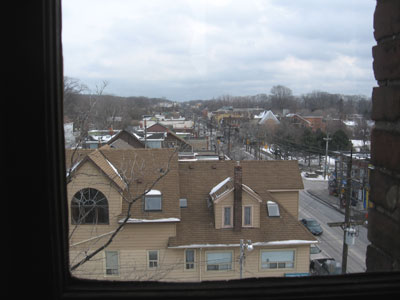
View over Queen Street East from the fire tower
So Doug started working at the North York Fire Department in 1984.
His dad foresaw the amalgamation that would happen between the five
former cities and boroughs that used to make up Metropolitan Toronto,
and this meant that Doug would have the chance to one day work right
in his beloved neighbourhood, the Beach. As the acting chief at
the Bermondsey and Eglinton Fire Hall, he was part of the east command.
Doug knew that Fire Station 227 was highly touted, and that firefighters
were lining up for years to get into this fire hall.
Then one day he got a phone call from his captain who said “How
would you like to walk to work on Monday?” Doug replied "I’ll
put on my running shoes and run to work”. The chief then said
“Don’t forget to bring breakfast on Monday”. He
has now been at Fire Station 227 for four years and loves it. On
occasion he brings his children Nicky and Aimee here, and sometimes
his neighbours and friends drop in to visit. Doug has a long waiting
list of people wanting to come and see the fire tower.
One interesting side effect of being a firefighter in his own neighbourhood
is that sometimes he gets called to help people that he knows. Just
recently there was an emergency call involving one of Doug’s
acquaintances. The man had had a heart attack, and Doug administered
first aid and encouraged him to hang on. Unfortunately the man did
not make it and passed away. Doug admits that these are strange
experiences.
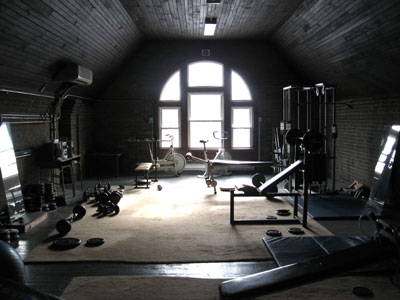
Exercise room on the third floor of Fire Station 227
Quite frequently Doug and his colleagues are down by the beach
in their fire boots, doing rescues. The calls are varied and range
from fires to water rescues and car accidents. But life as a firefighter
is not all about life-threatening rescues. There is a very strong
sense of camaraderie among the firefighters, and many of them are
actively involved in sports. Doug himself is an avid hockey player
and has been playing this sport since he was a child. His favourite
hockey rink continues to be the outdoor rink at Kew Gardens, just
10 minutes away from his fire hall.
Together with the Balmy Beach Old Boys, a hockey team at the Balmy
Beach Club, Doug has traveled to different hockey games in Europe
and visited countries such as Switzerland, Austria and Germany.
With the Toronto Buds, another hockey team, he toured England in
1992 and adds that hockey is his vehicle for travel and for building
international friendships. He also is a member of the Toronto Firefighters
Hockey League, he loves to keep active. Then Doug showed me a picture,
featuring him as a young hockey player at age 16. Also featured
in this photo is Lido Chilelli,
founder of the Toronto Beaches International Jazz Festival.
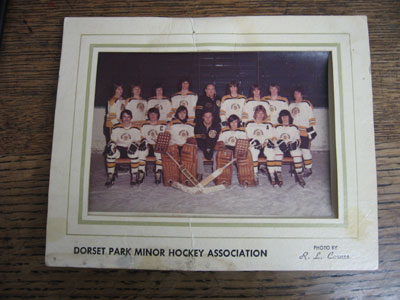
Photo featuring Doug as a junior hockey player (assistant captain,
front row, 2nd from right, Lido Chilelli is on the top right)
Doug has had a penchant for media and publicity for a long time.
He was also featured in the North York Firefighters calendar, an
experience which he describes as great fun and adds that he became
a minor celebrity. Proceeds from the calendar were donated to the
North York General Hospital. He chuckled and added that he met his
wife in his underwear and fire boots at a dance show, and they fell
instantly in love. His wife is a nurse at Toronto’s Sick Children’s
Hospital, and he describes their relationship ’like peanut
butter and jelly” – a firefighter and a nurse go together
like two peas in a pod.
His love for his neighbourhood has become evident over the years.
In 1989 he owned a store called “Beach Sports”. He felt
the area needed a little boost, so together with some schoolmates
and colleagues from the Fire Department he created the “Beach
sweatshirt”, promoting the neighbourhood. The store did well
until the GST (General Sales Tax) was introduced, and the group
reluctantly had to let the store go, but Doug enjoyed the experience
and has no regrets.
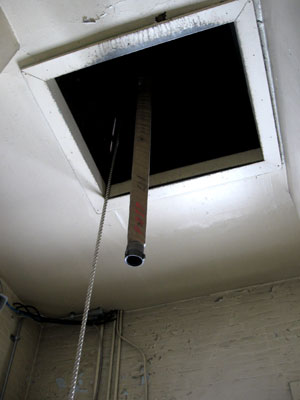
Fire hose hanging down to dry from the fire tower
After our initial conversation Doug was so kind as to take me on
another tour of the building, this time of the upper floors. He
showed me the dormitory where all the firefighters sleep and live
during their 24 hour shifts. Another floor up is an exercise room,
and Doug explained that today’s firefighters are all very
fit because the department encourages them to stay in shape. Up
we went into the fire tower, through a narrow set of stairs that
opened up into a small room with a beautiful view all over Queen
Street, with windows facing in all four directions. A great view
of the downtown skyline and the lake unfolded in front of my eyes.
I also peeked east over the Queen Street strip. Doug explained that
as a kid he would go swimming to the outdoor pool at the foot of
Woodbine Avenue, and he and his friends would always look at the
fire tower of the fire station to see whether it was time already
to go home.
From this small room we climbed up a vertical wooden ladder into
the room that features the four clock faces and the mechanism that
turns the hands of the clock. A central box in the middle of the
room turns four rods, each of which is connected to a mechanism
that turns the hands on the clock faces. I was tickled pink to be
up here in the fire tower and get a real behind-the-scenes look
at one of the true landmarks in the Beach, an experience that reminded
me of my trip to the roof and to the bowels of the Royal
York Hotel.

Doug Browne in the fire tower, in front of one of the historic clock
faces
After enjoying a beautiful view of the city in all directions Doug
and I climbed down again and I was ready to head out for lunch.
My stomach was growling and I was planning to check out Akida Restaurant
right across the street, a Japanese seafood house where I was planning
to have a well-deserved lunch.
Doug had been an extremely gracious host who made me feel completely
welcome and comfortable during my behind-the-scenes visit of Fire
Station 227. As we concluded the interview he added that he is proud
to be serving the community that he grew up in and added that the
Beach is a very special neighbourhood. Every time he turns the corner
at Woodbine and Queen he feels that he is coming home.
Doug sums it up with one statement: “Once a Beacher, always
a Beacher”.

Time for lunch, at the Akida Restaurant
Related Articles:
Celebrate Toronto
- An article series to celebrate my chosen home town
Gene Domagala - A human convenience
store of charity and community involvement in Toronto's Beach
Arie Nerman & the Beach Hebrew Institute:
The People's Synagogue
Vivetha Bistro: A popular spot
with eclectic food
Glenn Cochrane - Media
personality, author and expert fundraiser – a champion of
the Beach for almost 40 years
Michelle Gebhart: A
true Renaissance woman: from army brat to expert renovator, biker
lady, successful restaurateur & dedicated youth volunteer
Michael Prue: A working class success
story - from Regent Park to Queens Park
Alex Winch & the
Beach Solar Laundromat – Unstoppable when it comes to championing
renewable energy & innovative entrepreneurship
Mary Lee: A restaurant owner with a heart
for the arts
Marie Perrotta from the Pegasus
Community Project reaches for the stars
Burgie and Benedetta from the Konditor
coffeehouse create Austrian delicacies in Toronto's Beach
Bob Murdoch from Community Centre
55 - 25 years of community service in the Beach
Steve and Paul from Accommodating
the Soul B&B: hospitality with a personal touch
John Dowding: A private lesson in
photography from a true master
Lucille Crighton: A textile
arts Hall of Famer in Toronto's Beach
Lido Chilelli: Founder
of the Toronto International Beaches Jazz Festival
Fire Station 227: History, heroism
and local connections in the Beach
The Green Eggplant: Healthy Mediterranean
food and big solid portions
The Balmy Beach Club - Legend
by the Lake & Toronto's best-kept secret
The Garden Gate Restaurant a.k.a. "The
Goof" - Good food in the Beach since 1952
Ralph Noble: Firefighter,
lifesaver and creator of the most famous mural in the Beach –
a noble man indeed
Sandra Bussin
- City Councillor and Deputy Mayor shows me her neighbourhood
The Toronto Beach Rotary Club:
Service above Self and the joys of volunteering
The Beaches Lions
Club: Charity and community projects in the Beach since 1935
The Beach Business
Improvement Area: A general overview of the Beach and the merchants
and activities on Queen Street East
Maria Minna:
An Italian-Canadian immigrant story and a life-long fight for social
justice
The Beach Metro Community
News: Much more than just the news
The Kingston Road Business Community:
A neighbourhood undergoing revitalization and an integral part of
the Beach
Andrew Smith and Rachel Howard:
Creative entrepreneurs and dedicated community builders
Nevada's Ristorante: Where
hospitality is a family affair
Maria Minna: Another neighbourhood
walk and talk and discoveries along Queen Street East
St. Aidan's Church:The spirit of charity
in the Beach comes full circle
Gene Domagala takes me on a history
tour of the eastern and northern part of the Beach - a perfect day
of discovery
The Beaches Library: A centre
of learning for all ages
A walk along Kingston Road:
A shopping district definitely worth a visit
55 Division: Serving and protecting
- community policing in action
|